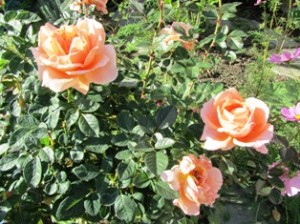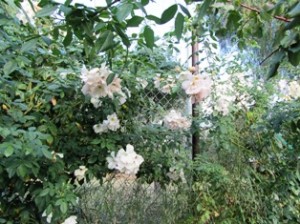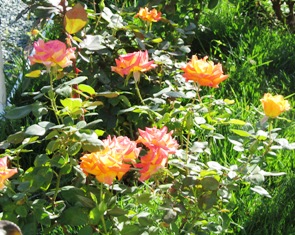Roses Add Romance to a Garden
Years ago, I wrote a book about interior decorating using flowers and floral motifs. I drew upon my appreciation of flowers to research and write that book with gal pal A. Bronwyn Llewellyn, author of Goddess at Home (interiors inspired by Greek goddesses). Because I so love the faded elegance of an English country motif where chintz and vintage floral designs reign supreme, I have included many types of old floral favorites as well as rose bushes around the Henny Penny Farmette.
Abbaye de Cluny (pictured above) seems to enjoy being tucked in a bed that includes French perfume lavender, rose geranium, cosmos, and Spanish lavender, and has become my favorite rose. It displays its splendor in the garden near my patio door where I can gaze upon it often. My son Josh gave me this rose for Mother’s Day 2011. Abbaye de Cluny offers a spicy citrus scent and about 30 petals in each apricot bloom. When mature it will reach four feet tall and spread to three feet wide. It likes full sun and well-drained soil. Abbaye de Cluny is a super easy rose to grow.
Another lovely rose that I started from a cutting, using root hormone and sticking the cutting directly into the ground as the winter rains started, was Climbing Sally Holmes. In two years, that rose has evolved into a ten foot bush that sprawls on the back fence. I’ve since taken other cuttings from it and started that rose in other areas. This Jackson & Perkins rose is a antique hybrid musk with three and one-half inch, long-lasting blooms. It provides drama for any setting, but especially a garden sitting area.
For me, a rose gives two gifts–its scent and its bloom. I usually won’t plant a rose that doesn’t hold the promise of both, however, I made an exception with a floribunda named Redgold. This rose is a show-stopper with its fiery dual coloring of red and gold. Its petal count is around 25 on blooms that are much smaller than the Abbaye de Cluny. But in a flower bed that includes climbers and hybrid teas, this rose holds its own. It likes to be feed a fish emulsion tea; I only water it as needed.
I do not spray any of my roses and because there is a healthy ecological balance in my garden (lots of lady bugs and praying mantises to feed on aphids and other pests), so far the roses are performing beautifully without human intervention.
 Facebook
Facebook Goodreads
Goodreads LinkedIn
LinkedIn Meera Lester
Meera Lester Twitter
Twitter







